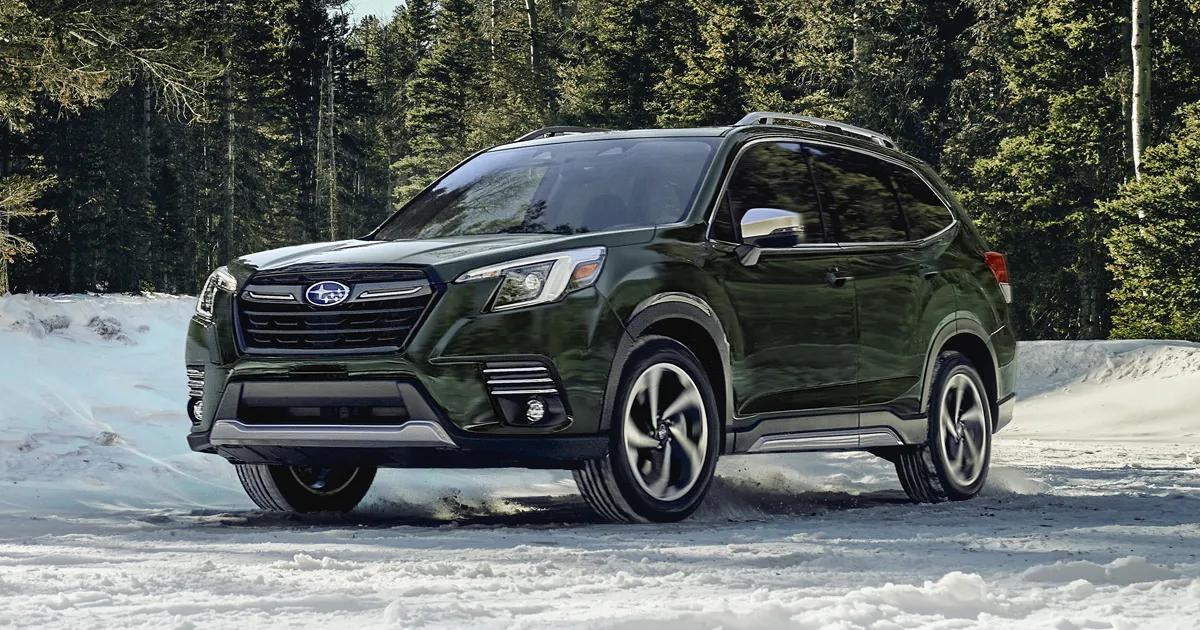 Subaru Forester 2023 Electronic Brake Force Distribution Base
Subaru Forester 2023 Electronic Brake Force Distribution Base
The 2023 Subaru Forester is a compact SUV from the Japanese automaker that has received updates to its safety features, performance, and design. One of the key safety features in the 2023 Forester is the Electronic Brake Force Distribution (EBD) system, which comes standard on all models. The EBD system is an advanced braking technology that ensures the brake force is distributed evenly among all wheels, even under challenging road conditions or when carrying a heavy load. This system helps prevent skidding and loss of control during emergency braking, which is particularly crucial for SUVs like the Forester. Along with EBD, the 2023 Forester also features a suite of advanced safety features that come standard, such as pre-collision braking, lane departure warning, and adaptive cruise control. Furthermore, the Forester offers ample passenger and cargo space, all-wheel drive as standard, and a variety of comfort and convenience features like a panoramic moonroof and a premium Harman Kardon audio system. Overall, the 2023 Subaru Forester is a versatile and practical SUV that offers an array of features and technologies to ensure your comfort and safety while driving.
2023 Subaru Forester Specs, Price, Features, Mileage (Brochure)
Electronic Brake Force Distribution
The EBD system maximizes the effectiveness of the brakes by allowing the rear brakes to supply a greater proportion of the braking force. It functions by adjusting the distribution of braking force to the rear wheels in accordance with the vehicle’s loading condition and speed. The EBD system is an integral part of the ABS and uses some of the ABS components to perform its function of optimizing the distribution of braking force. If any of the ABS components used by the EBD system malfunction, the EBD system also stops working. When the EBD system is operating, you may hear a chattering noise or feel a slight vibration in the brake pedal. This is normal and does not indicate a malfunction.
If the EBD system malfunctions
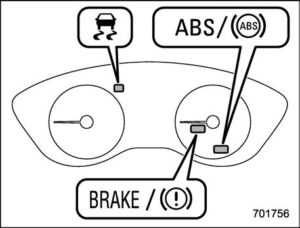
If a malfunction occurs in the EBD system, the system stops working and the following warning lights illuminate simultaneously. . Brake system warning light
- ABS warning light
- Vehicle Dynamics Control warning light
If the both warning light remains on even though the parking brake is released, the brake fluid level may be low or there could be a problem with the EBD system. Park the vehicle in a safe place immediately and contact a Subaru dealer.
WARNING
- Driving with the brake system warning light illuminated is dangerous. This indicates your brake system may not be working properly. If the light remains illuminated, have the brakes inspected by a SUBARU dealer immediately.
- If at all in doubt about whether the brakes are operating properly, do not drive the vehicle. Have your vehicle towed to the nearest SUBARU dealer for repair.
Vehicle Dynamics Control system
Safety precautions
WARNING
Always use the utmost care in driving – overconfidence because you are driving a vehicle with the Vehicle Dynamics Control system could easily lead to a serious accident.
CAUTION
- Even if your vehicle is equipped with the Vehicle Dynamics Control system, winter tires should be used when driving on snow covered or icy roads; in addition, vehicle speed should be reduced considerably. Simply having a Vehicle Dynamics Control system does not guarantee that the vehicle will be able to avoid accidents in any situation.
- Activation of the Vehicle Dynamics Control system is an indication that the road on which the vehicle is traveling has a slippery surface; since having Vehicle Dynamics Control is no guarantee that full vehicle control will be maintained at all times and under all conditions, its activation should be seen as a sign that the speed of the vehicle should be reduced considerably.
- Whenever suspension components, steering components, or an axle are removed from a vehicle, have an inspection of that system performed by an authorized SUBARU dealer.
- The following precautions should be observed in order to ensure that the Vehicle Dynamics Control system is operating properly:
- All four wheels should be fitted with tires of the same size, type, and brand. Furthermore, the amount of wear should be the same for all four tires.
- Keep the tire pressure at the proper level as shown on the vehicle placard attached to the driver’s side door pillar.
- Use only the specified temporary spare tire to replace a flat tire. With a temporary spare tire, the effectiveness of the Vehicle Dynamics Control system is reduced and this should be taken into account when driving the vehicle in such a condition.
- If non-matching tires are used, . If non-matching tires are used,
- The Vehicle Dynamics Control system helps prevent unstable vehicle motion such as skidding using control of the brakes and engine power. Do not turn off the Vehicle Dynamics Control system unless it is absolutely necessary. If you must turn off the Vehicle Dynamics Control system, drive very carefully according to the road surface conditions.
System features
In the event of wheelspin and/or skidding on a slippery road surface and/or during cornering and/or an evasive maneuver, the Vehicle Dynamics Control system adjusts the engine’s output and the wheels’ respective braking forces to help maintain traction and directional control.
- Traction Control Function
The traction control function is designed to prevent the spinning of the driving wheels on slippery road surfaces, thereby helping to maintain traction and directional control. Activation of this function is shown by flashing the Vehicle Dynamics Control operation indicator light. - Skid Suppression Function
The skid suppression function is designed to help maintain directional stability by suppressing the wheels’ tendency to slide sideways during steering operations. Activation of this function is shown by flashing the Vehicle Dynamics Control operation indicator light.
NOTE
-
- The Vehicle Dynamics Control system may be considered normal when the following conditions occur.
- Slight twitching of the brake pedal is felt.
The vehicle or steering wheel shakes to a small degree. - An operating sound from the engine compartment is heard briefly when starting the engine and when driving off after starting the engine.
- The brake pedal seems to jolt when driving off after starting the engine.
- In the circumstances shown in the following list, the vehicle may be less stable than it feels to the driver. The Vehicle Dynamics Control system may therefore operate. Such an operation does not indicate a system malfunction.
- On gravel-covered or rutted roads
- On unfinished roads
- When the vehicle is towing a trailer
- When the vehicle is fitted with snow tires or winter tires.
- Activation of the Vehicle Dynamics Control system will cause the operation of the steering wheel to feel slightly different compared to normal conditions.
- It is always important to reduce speed when approaching a corner, even if your vehicle is equipped with the Vehicle Dynamics Control system.
- Always turn off the engine before replacing a tire. Failure to do so may render the Vehicle Dynamics Control system unable to operate correctly.
Vehicle Dynamics Control OFF switch

Type A

Type B
Press or turn the Vehicle Dynamics Control OFF switch to deactivate the Vehicle Dynamics Control system. Creating adequate driving wheel slip by deactivating the Vehicle Dynamics Control system may help to recover from the loss of traction. Use the Vehicle Dynamics Control OFF switch as necessary.
- A standing start on a steeply sloping road with a snowy, gravel-covered, or otherwise slippery surface
- Extrication of the vehicle when its wheels are stuck in mud or deep snow
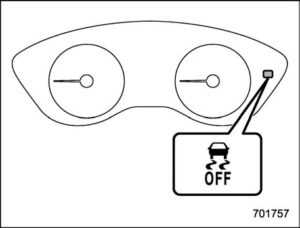
When the switch is pressed or turned during engine operation, the Vehicle Dynamics Control OFF indicator light “ ” on the combination meter illuminates. The Vehicle Dynamics Control system will be deactivated and the vehicle will behave like a model not equipped with the Vehicle Dynamics Control system. When the switch is pressed again (type A) or turned to the “NORMAL” side (type B) to reactivate the Vehicle Dynamics Control system, the Vehicle Dynamics Control OFF indicator light turns off. With the Vehicle Dynamics Control system deactivated, traction and stability enhancement offered by the Vehicle Dynamics Control system is unavailable. Therefore, you should not deactivate the Vehicle Dynamics Control system except under the above-mentioned situations.
NOTE
- When the switch has been pressed (type A) or turned (type B) to deactivate the Vehicle Dynamics Control system, the Vehicle Dynamics Control system automatically reactivates itself the next time the ignition switch is turned to the “LOCK”/ “OFF” position and the engine is restarted.
- If the switch is pressed (type A) or turned (type B) and held for 30 seconds or longer, the indicator light turns off, the Vehicle Dynamics Control system is activated, and the system ignores any further pressing of the switch. To make the switch usable again, turn the ignition switch to the “LOCK”/“OFF” position and restart the engine.
- When the switch is pressed (type A) or turned (type B) to deactivate the Vehicle Dynamics Control system, the vehicle’s running performance is comparable to that of a vehicle that does not have a Vehicle Dynamics Control system. Do not deactivate the Vehicle Dynamics Control system except when absolutely necessary.
- Even when the Vehicle Dynamics Control system is deactivated, components of the brake control system may still activate. When the brake control system is activated, the Vehicle Dynamics Control operation indicator light flashes.
X-MODE (if equipped)
- Always use the utmost care in driving – overconfidence because you are driving a vehicle with X-MODE could easily lead to a serious accident.
- Always use the utmost care in driving – overconfidence because you are driving a vehicle with a hill descent control function (if equipped) could easily lead to a serious accident. Be especially careful, and depress the brake pedal if necessary when driving on extremely steep downhill, frozen, muddy, or sandy roads. Failure to control the vehicle’s speed may cause a loss of control and result in a serious accident.
CAUTION
- Even if your vehicle is equipped with X-MODE, winter tires should be used when driving on snow-covered or icy roads; in addition, vehicle speed should be reduced considerably. Simply having X-MODE does not guarantee that the vehicle will be able to avoid accidents in any situation.
- Activate X-MODE when you encounter a very slippery surface at low speed. However, having X-MODE is no guarantee that full vehicle control will be maintained at all times and under all conditions. When activating X-MODE, the speed of the vehicle should be reduced considerably.
- Whenever suspension components, steering components, or an axle are removed from a vehicle, have the system inspected by an authorized SUBARU dealer.
- Observe the following precautions in order to ensure that X-MODE is operating properly:
- All four wheels should be fitted with tires of the same size, type, and brand. Furthermore, the amount of wear should be the same for all four tires.
- Keep the tire pressure at the proper level as shown on the label attached to the vehicle’s door pillar.
- Use only the special temporary spare tire to replace a flat tire. With a normal temporary spare tire, the effectiveness of X-MODE is reduced and this should be taken into account when driving the vehicle in such a condition.
- Models with hill descent control:
If the hill descent control function has operated continuously for a long time, the temperature of the brake disc may increase and the hill descent control function may be temporarily disabled. In this case, the hill descent control indicator will disappear. When the hill descent control indicator disappears, the hill descent control function is disabled.
X-MODE is the integrated control system of the engine, AWD Vehicle Dynamics Control system, etc. for driving in bad road conditions. Using X-MODE, you can drive more comfortably even in slippery road conditions including uphill and downhill.
X-MODE has the following functions.
- Hill descent control function (if equipped):
Using the hill descent control function, you can keep the vehicle at a consistent speed driving downhill. If the vehicle speed is likely to increase, the brake control system will be activated to adjust the vehicle speed.
- Driving ability control:
This mode increases the hill-climbing ability and driving ability as well as enables smooth application of torque for easier control of the steering wheel.
To activate/deactivate X-MODE
X-MODE switch (models with 2 modes)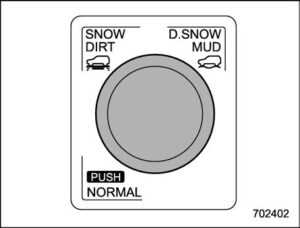
Type A
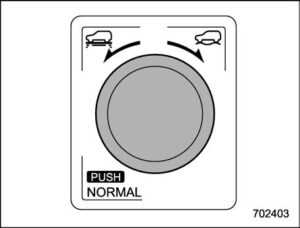
Type B
X-MODE switch (models with 1 mode)
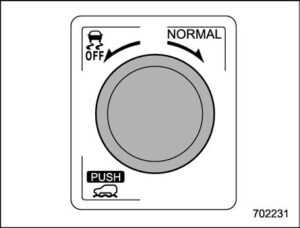
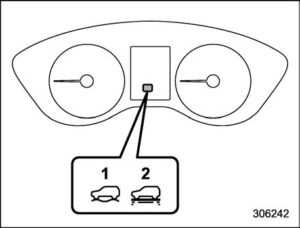
X-MODE indicator (models with 2 modes) 1 D.SNOW/MUD mode indicator 2 SNOW/DIRT mode indicator

X-MODE indicator (models with 1 mode)
To activate
Models with 2 modes
Turn the X-MODE switch to the right or left and select SNOW/DIRT or D.SNOW/MUD. While X-MODE is activated, the X-MODE indicator appears.
Models with 1 mode
Press the X-MODE switch. While X-MODE is activated, the X-MODE indicator appears.
To deactivate
Press the X-MODE switch. The X-MODE indicator will disappear when X-MODE is deactivated.
NOTE
- SNOW/DIRT is suitable for driving on a snow-covered road where the points of contact between the tires and road surface are visible, or for driving on an unpaved road.
- D.SNOW/MUD is suitable for driving on a road covered with deep snow where the points of contact between the tires and road surface are not visible, or for driving on a muddy road.
- Even if you try to activate X-MODE by turning (models with 2 modes) or pressing (models with 1 mode) the X- MODE switch when the vehicle speed is 12 mph (20 km/h) or more, X-MODE will not be activated. At this time, a buzzer will sound twice.
- If the vehicle speed reaches 25 mph (40 km/h) or more while X-MODE is activated, a buzzer will sound once and X-MODE will be deactivated. X-MODE will automatically reactivate when the vehicle speed drops below 22 mph (35 km/h).
- When you use the cruise control after X-MODE is automatically deactivated, X-MODE will not be automatically reactivated when the vehicle speed drops below 22 mph (35 km/h).
- If the engine could overheat because of a temperature increase of the engine coolant, it may not be possible to activate X-MODE. Even while X-MODE is activated, X-MODE will be deactivated when the engine coolant temperature increases.
- The Auto Start Stop system will be stopped while X-MODE is activated.
NOTE
- The SI-DRIVE mode will change to the Intelligent (I) mode when X-MODE is deactivated.
- The SI-DRIVE mode cannot be changed while X-MODE is activated. At this time, a buzzer will sound twice.
- X-MODE will be deactivated if any of the following conditions is met while the engine is running.
- The CHECK ENGINE warning light/malfunction indicator light illuminates.
- The AT OIL TEMP warning light flashes.
- The ABS warning light illuminates.
- The Vehicle Dynamics Control warning light illuminates.
When this occurs, it is not possible to activate X-MODE. Also, for models with SI-DRIVE, type A changes to the Sport (S) mode, and type B remains in the state that was in effect before the warning light turned on. In this case, it is not possible to change to another mode.
- If there is a possibility that the engine could overheat because of a temperature increase of the engine coolant, it is not possible to change to X-MODE. While the vehicle is in X-MODE, it changes to the Sport (S) mode or Sport Sharp (S#) mode when the engine coolant temperature increases.
- It is not possible to activate X-MODE when the engine is not running, because the hill descent control function is not activated.
- . When X-MODE automatically reactivates, the hill descent control function also reactivates.
Hill descent control function
The hill descent control function will be in standby mode when X-MODE is activated and the vehicle speed is less than approximately 12 mph (20 km/h). The function will operate when the vehicle speed is less than approximately 12 mph (20 km/h) and the accelerator ratio is less than approximately 10%. The function will turn off when the vehicle speed is more than approximately 12 mph (20 km/h) and the accelerator pedal is depressed.
CAUTION
The braking power of the hill descent control function may not be sufficient when strong braking power is needed (e.g., when towing a trailer).
NOTE
- Even while the hill descent control function is operating, you can vary the vehicle speed using the brake pedal or accelerator pedal.
- During braking by the hill descent
control function, the stop lights will illuminate. - The hill descent control function is operable regardless of the gradient of the road.
- The hill descent control function may be considered normal when the following conditions occur.
- An operating sound is heard briefly from the engine compartment while the hill descent control function is operating.
- The sensation of depressing the brake pedal is different, (harder than usual etc.) when the brake pedal is depressed during hill descent control function operation.
Hill descent control indicator
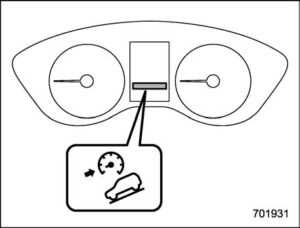
Hill descent control indicator
This indicator appears while the hill descent control function is in standby mode. It flashes while the function is operating. It will disappear when the function is in the disabled mode. When this function is changed from operational to non-operational, it will disappear when the vehicle speed reaches more than approximately 18 mph (30 km/h).
Tire pressure monitoring system (TPMS) (U.S.-spec. models)
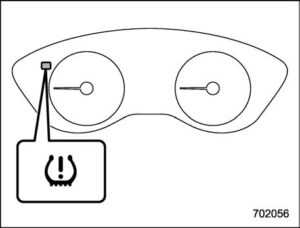
Low tire pressure warning light
The tire pressure monitoring system provides the driver with a warning message when tire pressure is severely low. The tire pressure monitoring system will activate only when the vehicle is driven at speeds above 20 mph (32 km/h). Also, this system may not react immediately to a sudden drop in tire pressure (for example, a blowout caused by running over a sharp object).
WARNING
- If the low tire pressure warning light illuminates while driving, never brake suddenly. Instead, perform the following procedure. Otherwise, an accident involving serious vehicle damage and serious personal injury could occur.
- Keep driving straight ahead while gradually reducing speed.
- Slowly pull off the road to a safe location.
- Check the pressure for all four tires and adjust the pressure to the COLD tire pressure shown on the tire inflation pressure label. The tire inflation pressure label is located on the door pillar on the driver’s side.
Even when the vehicle is driven a very short distance, the tires get warm and their pressures increase accordingly. Be sure to let the tires cool thoroughly before adjusting their pressures to the standard values shown on the tire inflation pressure label. The tire pressure monitoring system does not function when the vehicle is stationary. After adjusting the tire pressures, increase the vehicle speed to at least 20 mph (32 km/h) to start the TPMS rechecking of the tire inflation pressures. If the tire pressures are now above the severe low-pressure threshold, the low tire pressure warning light should turn off a few minutes later. If this light still illuminates while driving after adjusting the tire pressure, a tire may have significant damage and a fast leak that causes the tire to lose air rapidly. If you have a flat tire, replace it with a spare tire as soon as possible.
- When a spare tire is mounted or a wheel rim is replaced without the original pressure sensor/transmitter being transferred, the low tire pressure warning light will illuminate steadily after blinking for approximately 1 minute. This indicates the TPMS is unable to monitor all four road wheels. Contact your SUBARU dealer as soon as possible for tire and sensor replacement and/or system resetting.
- When a tire is repaired with liquid sealant, the tire pressure warning valve and transmitter may not operate properly. If a liquid sealant is used, contact your nearest SUBARU dealer or another qualified service shop as soon as possible. Make sure to replace the tire pressure warning valve and transmitter when replacing the tire. You may reuse the wheel if there is no damage to it and if the sealant residue is properly cleaned off. Do not inject any tire liquid or aerosol tire sealant into the tires, as this may cause a malfunction of the tire pressure sensors. If the light illuminates steadily after blinking for approximately 1 minute, promptly contact a SUBARU dealer to have the system inspected.
CAUTION
Do not place metal film or any metal parts in the cargo area. This may cause poor reception of the signals from the tire pressure sensors, and the tire pressure monitoring system will not function properly.
NOTE
This device complies with part 15 of the FCC Rules. Operation is subject to the following two conditions:
- This device may not cause harmful interference, and
- This device must accept any interference received, including interference that may cause undesired operation.
FCC CAUTION
Changes or modifications not expressly approved by the party responsible for compliance could void the user’s authority to operate the equipment.
FAQ
What is the Electronic Brake Force Distribution (EBD) system in the 2023 Subaru Forester?
The EBD is an advanced braking system that ensures that the brake force is distributed evenly among all wheels, preventing skidding and loss of control in emergency braking situations.
Is the EBD system standard on all 2023 Forester models?
Yes, the EBD system is standard on all 2023 Forester models.
What other safety features come standard on the 2023 Forester?
The 2023 Forester comes standard with adaptive cruise control, lane departure warning, and pre-collision braking.
What type of engine does the 2023 Forester have?
The 2023 Forester comes equipped with a 2.5-liter 4-cylinder engine.
Is all-wheel drive standard on the 2023 Forester?
Yes, all-wheel drive is standard on all 2023 Forester models.
How much cargo space does the 2023 Forester offer?
The 2023 Forester offers up to 76.1 cubic feet of cargo space with the rear seats folded down.
How many passengers can the 2023 Forester seat?
The 2023 Forester can seat up to five passengers.
What type of transmission does the 2023 Forester have?
The 2023 Forester comes equipped with a continuously variable transmission (CVT).
What is the fuel economy of the 2023 Forester?
The 2023 Forester has an estimated fuel economy of up to 26 mpg in the city and 33 mpg on the highway.
What are some of the available comfort and convenience features in the 2023 Forester?
The 2023 Forester offers a range of comfort and convenience features, such as a panoramic moonroof, heated front and rear seats, a power liftgate, and a Harman Kardon premium audio system.
What are the different trim levels available for the 2023 Forester?
The 2023 Forester is available in five trim levels: Base, Premium, Sport, Limited, and Touring.
What is the starting price of the 2023 Forester?
The starting price of the 2023 Forester is $25,795.
What are some of the design updates in the 2023 Forester?
The 2023 Forester features updated front and rear styling, new wheel designs, and updated interior materials.
Does the 2023 Forester offer any off-road capabilities?
Yes, the 2023 Forester offers off-road capabilities with its standard all-wheel drive and 8.7 inches of ground clearance.
What is the warranty coverage for the 2023 Forester?
The 2023 Forester comes with a 3-year/36,000-mile basic warranty and a 5-year/60,000-mile powertrain warranty.
Useful Link
View Full User Guide: Subaru Forester 2023 Base User Guide
Download Manuals: https://www.subaru.com/owners/vehicle-resources/manuals.htm
2023 Subaru Forester Specs, Price, Features, Mileage (Brochure)

